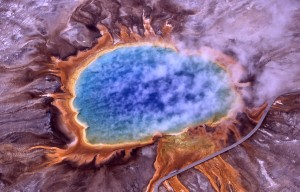Geologists are setting a Stopwatch for a Yellowsto...
Geologists assess the potential for future eruptions at Yellowstone volcano by studying those in the recent pa...

On July 1, 2015, the Geology journal published an article titled “Months between rejuvenation and volcanic eruption at Yellowstone caldera, Wyoming” about volcano activity in Yellowstone National Park. We have asked one of the authors of the research, Prof. Christy Till, to comment on this work.
Scientists from Arizona State University, the United States Geological Survey, and University of California, Los Angeles have found that the last time Yellowstone volcano erupted after sitting dormant for a long time, the eruption was triggered within 10 months of new magma moving into the base of the volcano, while other times it erupted closer to the 10 years after magma ascent. Over the last 15 years one of the biggest advances in the study of igneous petrology – the study of rocks that are formed from magmas and lavas – has been the realization that magma bodies are often composite features, i.e., they tend to be built progressively by many injections of magma and subsequent cooling. If magma doesn’t erupt after an injection event, it will sit in the crust and slowly cool, forming crystals. And it can sit in that state – mostly crystals with a tiny amount of liquid magma – for a very long time. Under Yellowstone, this is exactly what is observed today: two large magma chambers at different depths containing less than 6% liquid. Over tens to hundreds of thousands of years the last little bit of this magma will crystallize unless it becomes reheated by another magma injection, which if sufficiently large will lead to eruption. The big question was, “How quickly can you reheat a cooled magma chamber and get it to erupt?”

To answer this question, ASU Professor Christy Till (ASU) and colleagues Jorge Vazquez (USGS) and Jeremy Boyce (UCLA) reconstructed the history of one of Yellowstone’s youngest magmas as it prepared to erupt by analyzing the zones in its crystals that grow like tree rings and record changes in the crystal’s environment through time. The study employed a new analysis technique that can measure very sharp chemical gradients over very short distances (~10 nanometres = 1.0 × 10-8 meters) in the crystals, which allowed the short time between the reheating event and eruption to be calculated. In addition, the behavior of several different elements (barium, strontium and magnesium) was used for the time estimates, which turned out to be crucial to verifying the very short timescales. The results suggest an eruption at the beginning of Yellowstone’s most recent volcanic cycle was triggered within 10 months after reheating of a mostly crystallized magma reservoir following a 220,000-year period of volcanic quiescence. Thus a similarly energetic reheating of Yellowstone’s current sub-surface magma bodies could end the present-day ~70,000 years of volcanic quiescence and lead to a future eruption over similar timescales. Fortunately any significant reheating event is likely to be identifiable because of the associated earthquakes.
Yellowstone and other caldera volcanoes with protracted histories of eruption such Long Valley (California, USA) and Taupo (New Zealand) tend to be most famous for their super-eruptions – eruptions that produce lava flows, ash layers and other volcanic deposits that exceed volumes of 1000 cubic kilometers. However, these types of volcanoes also produce much smaller, less explosive eruptions on a more frequent basis. For example, Yellowstone has had at least 23 smaller eruptions since its last super-eruption ~631,000 years ago, making this type of eruption more likely than a super-eruption. Although smaller than super-eruptions, these more frequent eruptions are still the size of the largest eruptions of the 20th Century, such as the 1991 Pinatubo eruption (~5 km3), and could pose a considerable volcanic hazard. In order to evaluate the potential for future eruptions at Yellowstone and other caldera volcanoes, the authors were motivated to determine how quickly the volcano could amass the amount of magma necessary to produce one of these smaller eruptions. In addition, the availability of new technology to analyze the crystal zones at the very small spatial scale necessary greatly improved likelihood of being able to precisely determine such short timescales, further motivating the authors.
The use of zoned crystals to determine geologic rates has been successfully applied to a wide range of igneous, metamorphic and planetary processes in the past, including the cooling of meteorites and the exhumation of metamorphic provinces. The recent application of this technique to volcanic deposits has opened the door to documenting the timing of past eruptions as in this study, with many more similar studies likely to follow. When coupled with the recent advances in analytical techniques that permit the collection of data from chemically or isotopically zoned minerals on the nanometer scale, this technique can resolve events that occur over short geologic timescales (<104 years) that are very difficult to resolve with other geochronologic techniques. Therefore the future of building volcanic hazards models suitable for predicting the likelihood and timing of volcanic eruptions at active volcanoes looks bright.

Geologists assess the potential for future eruptions at Yellowstone volcano by studying those in the recent pa...

Geologist Philip Gibbard on Louis Agassiz, the Quaternary, and the Effects of Global Warming

New Nature article debate dating of nitrogen fixation emergence